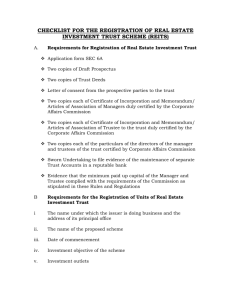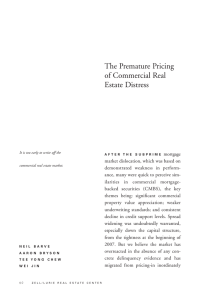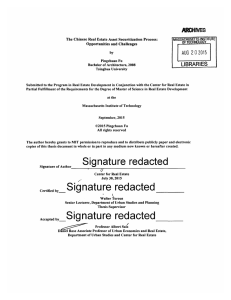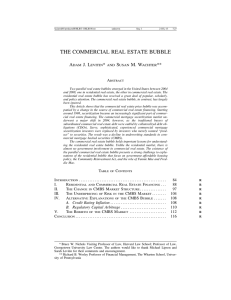REITs - Taiwan Ratings
advertisement
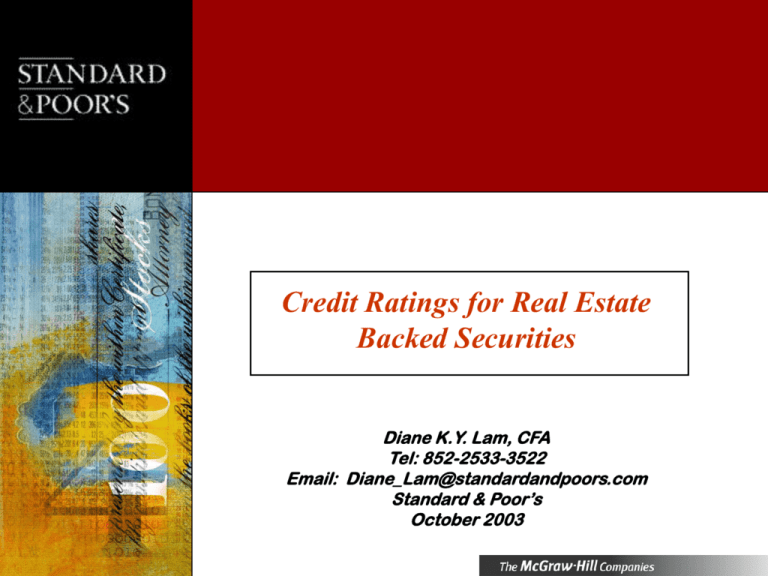
Credit Ratings for Real Estate Backed Securities Diane K.Y. Lam, CFA Tel: 852-2533-3522 Email: Diane_Lam@standardandpoors.com Standard & Poor’s October 2003 Today’s Agenda • Trends in debt capital markets for real estate backed securities • Evaluation of REIT • Evaluation of commercial mortgage backed securities (CMBS) • What are the implications for Taiwan? CMBS Rating vs.LPT Corporate Rating Credit Risk Spectrum Unsecured Corporate Debt (risk is default of entity) Secured Corporate Debt Reduced Credit Risk 3 Structured Finance (insolvency remote issuer; risk is asset related) Debt Capital Markets Offerings for Real Estate Real Estate Structured Finance REITS Residential Mortgage Backed Securities (RMBS) Commercial Mortgage Backed Securities Pool Transactions Corporate Issuer Ratings Credit Lease Transactions Property Specific Transactions Single Borrower / Single Property Single Borrower / Multiple Properties 4 Multiple Borrowers / Multiple Properties The Value of Credit Ratings Issuers • • Intermediaries Enlarge the universe of potential investors • More favorable credit terms • Investors Facilitate the pricing and placement of securities • Global measure of credit risk Monitor counterparty risk • Portfolio monitoring 5 • Benchmark for risk premium Performance of REITs in other Countries Case Study: US Real Estate Investment Trusts (REITs) in the United States: – – – – – Created in 1960 to enable small investors to invest in real estate. Slow start but picked up in the 1990s after tax reforms and property downturn (companies saw them as an efficient way to access capital). There are currently 300 REITs operating in the United States. Total assets under management currently over US$300 billion. Approximately two-thirds are trade on the national stock exchange. 7 Case Study: Australia Listed Property Trusts (LPT) in Australia: – – – – – Launched in the early 1980s The LPT sector has been one of the strongest performing sectors of the Australian Stock Exchange (ASX). The capitalisation of Australia's listed property trusts represents seven percent of the ASX. There are presently more than 38 listed property trusts on the ASX and these are capitalised at more than A$50 billion. REITs own around 50% of an estimated A$120 billion of institutional quality property in Australia 8 Case Study: Asia Japan – – – Korea – – – J-REITs were launched in Japan in 2000 Real estate to account for more than 50% of total assets. There are currently six registered J-REITs in the market. Property trusts were launched in Korea in 2001. There are two types of trust: K-REITs and CR-REITs. K-REITs are not preferred by investors because dividend income is taxable (there are some exemptions). Singapore – S-REITs were launched in 2002. – Three S-REITs in the market CapitaMall (retail) and Ascendas (industrial) and Fortune Reits (retail). Hong Kong – Enabling legislation launched in 2003 9 Global REIT Overview Start Date Distribution US 1960 >90% Netherlands 1970 >80% <60% no Australia 1970 100% <60% no Belgium 1990 >80% <50% no Canada 1994 85% - 100% <50% restricted Singapore 1999 0-100% <35% no Japan 2000 >90% <25% no Korea 2002 [varies] [varies] restricted Hong Kong 2003 >90% <35% restricted France 2003 >85% no limit no 10 Gearing Development restricted Case Study: Attractive Yield 8.0% 8 7.06% 6 (%) 4.44% 4.01% 4 2.50% 2.83% 3.16% 3.19% 2 0.50% 0 12 Month CPF (Ordinary Deposit Rate (1) Account) (2) SESPROP Dividend Yield (3) STI Equity Index (3) 10 Year Government Bond (3) OCBC Sub due 2011(3) (5%-BBB+) Notes: (1) Domestic interbank overnight interest rate as at December 27, 2002. (2) Based on interest paid on CPF Ordinary Account from Oct 1, 2002 to December 31, 2002. (3) Straits Times Index. 11 UOB Sub Notes due 2016(3) (4.95% -A-) CapitaMall A-REIT Yield at IPO Global CMBS Issuance 1985-2002 US$ (bn) US Non US 90 80 70 60 50 40 30 20 10 0 85 86 87 88 89 90 91 92 93 94 Year 12 95 96 97 98 99 '00 '01 '02 YTD CMBS Market in Australia 13 CMBS Market In Japan • Growth Factors: • Corporate restructuring—divesting owned real estate • Establishment of JREIT market • Efforts of the RCC to securitise non-performing pools • Liquidations of real estate portfolios by failed companies • Emergence of some performing loan conduits—still sporadic • Challenges: • Securitization continues to be lender of last resort • Still faces competition from direct lending market 14 CMBS Market In Korea • Growth Factors: • Corporate restructuring—divesting owned real estate • Establishment of REITS enabling legislation • Securitization of non-performing NPL loans held by private equity firms • Challenges: • Tenant Rights and Tenant Senior Liens (Chonsae) • Still faces competition from direct lending market 15 CMBS Market In Hong Kong & Singapore • Growth Factors: • Corporate restructuring—divesting owned real estate • Establishment of REITS • Challenges: • Valuation Gap • Still faces competition from direct lending market 16 What is a REIT? • • • • • Equity - The shares or unit trusts are usually traded on the stock exchange. Most REITs remit at least 90% of their income to shareholders. REITs are usually not required to pay income tax. A REIT is a company that owns and, in most cases, operates income producing real estate. Laws differ across geographic locations, but broad parameters are similar. 17 Structure of REITs 18 The REITS Ratings Approach Industry Characteristics Trust Operational Risk Financial Risk/Flexibility The company’s business risk profile determines the level of financial risk appropriate for a rating category. 19 Degree of Operating Risk Specific trust risk factors. . Financial risk is portrayed largely through quantitative ratios. Rated REITs in Asia Pacific Rated Property Trusts in Asia Pacific Credit Rating Outlook Business Singapore CapitaMall Trust A- Stable Property trust Australia AMP Diversified Property Trust AMP Office Trust AMP Shopping Centre Trust CFS Gandel Retail Trust Commonwealth Property Fund Deutsche Office Trust General Property Trust Macquarie Office Trust (Class-A notes) Principal Office Fund Stockland Trust Group Westfield Trust A AA AABBB+ A+ AAA AAA Stable Stable Stable Positive Stable Stable Stable N.A. Stable Stable Stable Property trust Property trust Property trust Property trust Property trust Property trust Property trust Commercial (mortgage-backed securities) Property trust Property trust Property trust Japan Japan Real Estate Investment Corp. Office Building Fund of Japan, Inc. A+ A Stable Stable Property trust Property trust 20 What is a CMBS • • • • • Debt -- Fixed Income Securities backed by real estate Issuer contracts to pay a stated coupon to investor Issuer contracts to repay principal to investor over the tenor of the bond Issuer is typically tax neutral Issuer is a SPV company that either owns operates income producing real estate or owns a secured loan backed by real estate. 21 CMBS Characteristics Noteholders Liquidity Facility Security Trustee Notes Issuer (SPV) Interest & Principal Payments Secured Loan Swap Counterparty Capex, Relet & Other Reserves Owner/Borrower (eg. REIT) Property Management Trustee Property Assets Lease Payments ($) Tenants 22 The CMBS Rating Approach • Transaction enquiry • Desk top review of collateral, indicative ranges provided • Staged engagement entered into • Detailed review of collateral, site visits, underwriting • S&P assessed collateral values, stabilised cash flows, loanto-value and debt-service-coverage-ratio’s assigned • Proceed onto second stage – YES/NO?? • Review of building condition, environmental and general due diligence information (including requirements for reserves) • Transaction documents • Ratings assigned 23 Major Issues to Examine Property industry characteristics: Cyclical trends Competition Economic outlook Structural Considerations: Interest rate risks, F/X risk Insurance requirements Liquidity Lines, Reserves Collections Management/Commingling Risks Refinancing Risk Amortizing Debt or Bullet Debt Asset Quality and Stability of Cash Flow: Diversification Rent review details Tenant quality Asset Valuation Consideration Stabilized cashflows & yields Determine valuation Is loan to value appropriate for the target rating Lease maturity profile Vacancy & Re-letting reserves Capital expenditures Management evaluations: Property Manager’s Expertise Rental Manager’s Expertise Credit control and administration Cash Flow Consideration Determine refinancing constant Is the debt service coverage ratio appropriate for the target rating Legal Considerations: Creditor’s rights on real estate security Liquidation process and timeframe Bankruptcy remoteness of the Issuer (SPV) 24 Distinction with a CMBS Rating • Issuer rating vs. issue rating • Corporate approach incorporates REIT’s business strategy and asset profile for a rolling five year period. It is our opinion of an issuers capacity to pay its financial obligations • CMBS seeks to protect the bondholder from the REIT’s insolvency risk. CMBS rates to the bond documents underpinned by income from the rental property. The rating takes into account recovery prospects • Default rating vs. ultimate recovery 25 CMBS Rating vs. REIT/Real Estate Issuer Rating CMBS Issuer/CCR First registered mortgages Security not required Detailed analysis of security value and cashflows Portfolio-wide analysis of assets Explicit LTV and DSCR thresholds No LTV and DSCR controls Finite tenor of bonds “Reasonable” term (ie open duration) Liquidity facility (may be required) No liquidity facility required Bankruptcy remote SPV issuer Corporate risk considered Dealing with assets – prescribed limits and controls Dealing with assets – corporate strategy related Predetermined limitations regarding additional debt Corporate strategy regarding debt considered Provisioning for potential liabilities (capex and relet) No cashflow provisioning for potential liabilities Cashflow and waterfall controls No cashflow controls required Rating reflects probability of default (inc. recovery) Rating reflects probability of default 26 Case Study: CMBS and REITS 27 Case Study: CapitaMall Trust Trust: Country: Type: Lettable area: Management: Sponsor: Listed: S&P rating: Placement: Listed yield: CapitaMall Singapore Shopping malls 813,352 sq. ft CapitaMall Trust Management Subsidiary of CapitaLand July 2002 A-/stable 60-70% institutional 7.2% 28 Case Study: Silver Maple Investment Corp. Ltd. Issuer: Country: Sponsor: Closed: S&P rating: Placement: Coupon: Maturity: Silver Maple Investment Corp. Ltd. Singapore CapitaMall Trust February 2002 (class A-1) June 2003 (class A-2) class A-1 Sing $ 172MM ‘AAA’ class A-2 US$ 73MM ‘AAA’ class B Sing $ 52MM ‘A’ private, single investor floating rate December, 2011 29 Outlook for Real Estate Backed Securities in Asia • Diversification in portfolio • Can offer high income and stable yields (example: REITS) • Can offer bond backed by real estate security which are immune to event risks (example: CMBS) • Demands of investor base (pension funds, insurance companies, banks) • Demographics (aging population seeks income, preservation of capital) 30 Implications for Taiwan? Lessons From Global Trends: • Capital markets can allocate funds efficiently for real estate assets – RMBS, CMBS and REITS vs. corporate bond vs. equity • Real estate backed securities provide high quality investments for investors • New source of funding for real estate would alleviate the concentrated risk of Taiwan bank to real estate • New source of stable revenue (property management fees) is beneficial to developers • Setting clear legal, security, accounting and tax legislations are critical to establishing REIT and CMBS markets in Taiwan • Capital market transaction propels the industry to higher levels of standard and accountability (valuation, management and reporting) • Capital market is efficient in pricing risk and return (and will differentiate high quality assets from poor quality assets) • Cultivate and educate the investors 31 32






